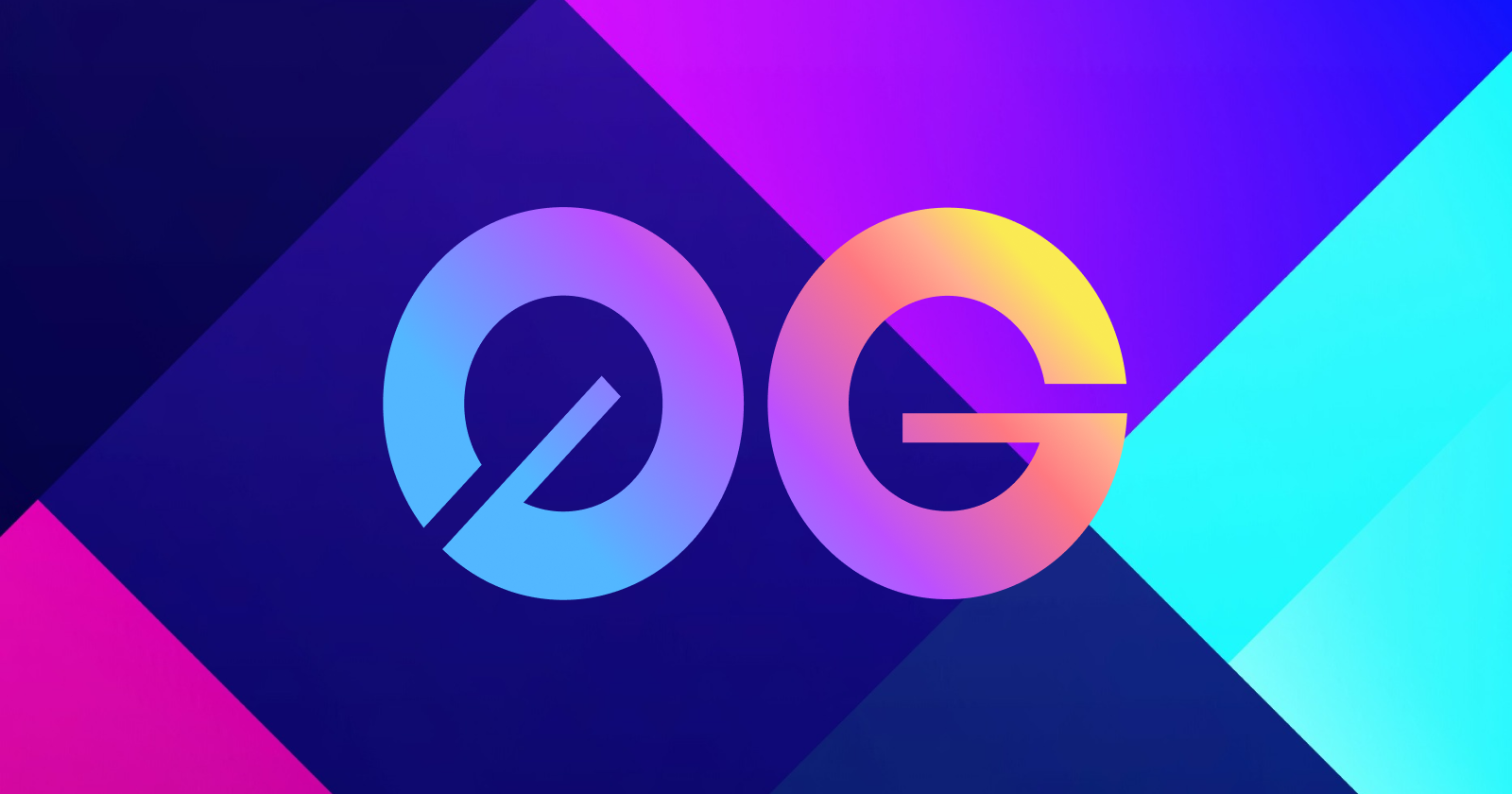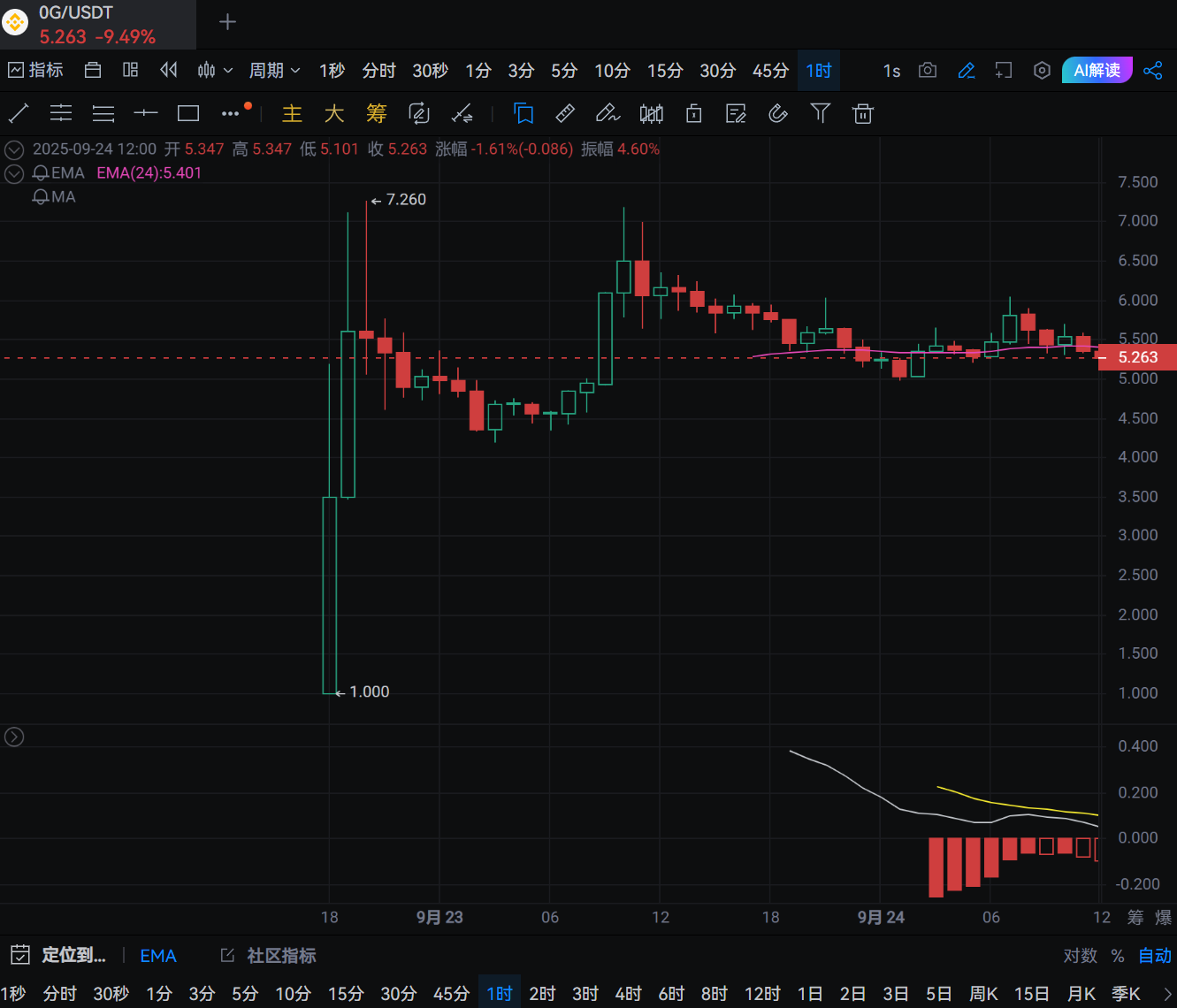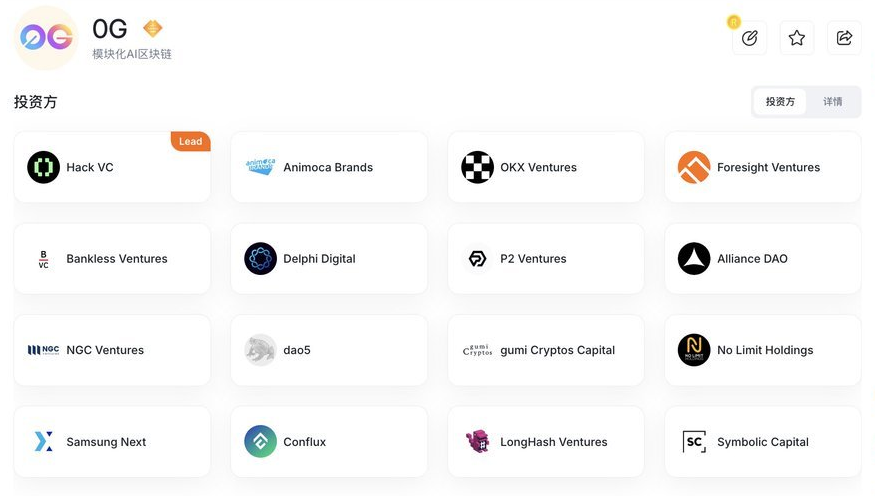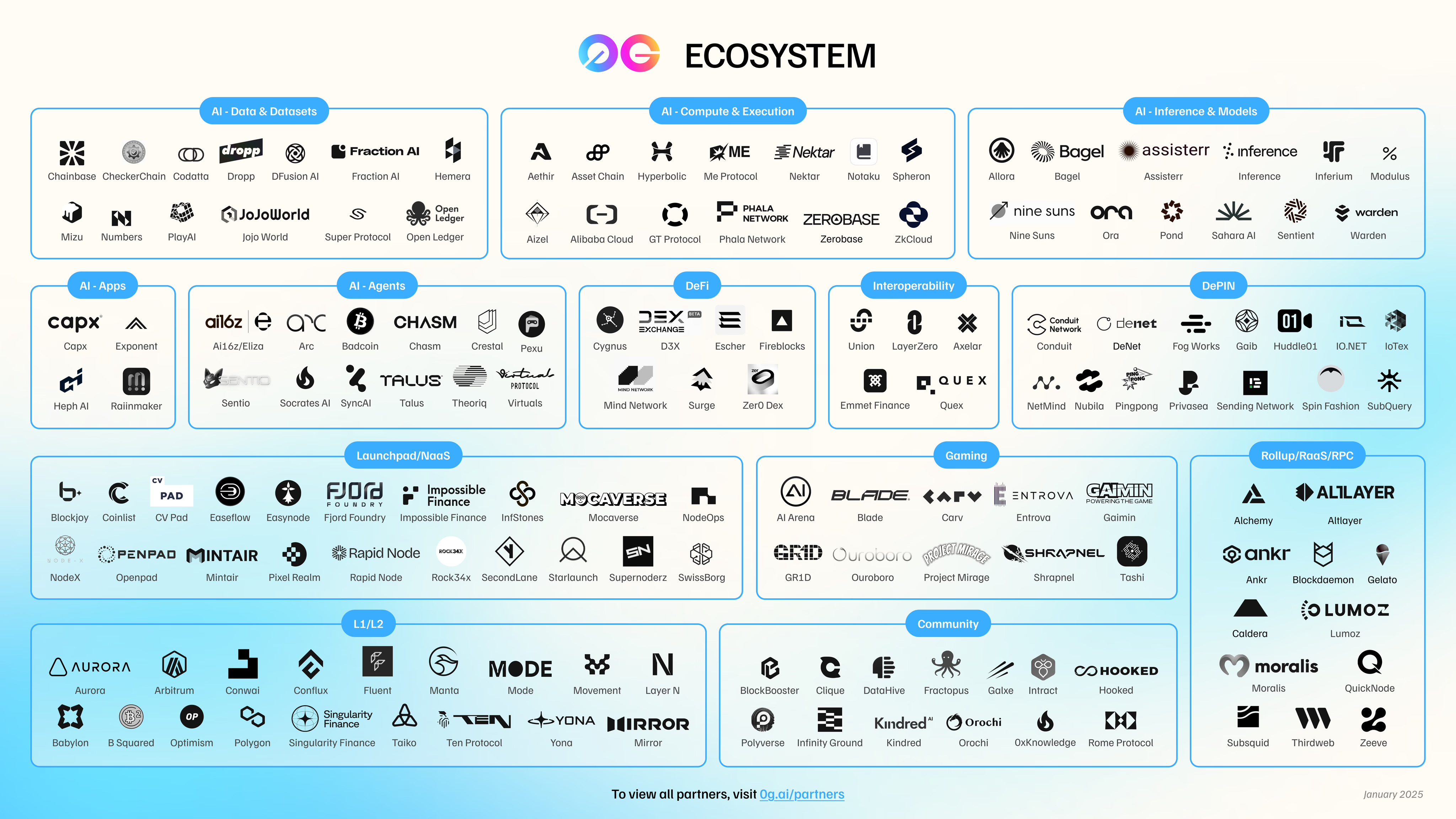Author: J1N, Techub News
In just a few days, leading exchanges such as Binance, OKX, Upbit, and Kraken have launched a highly anticipated AI public chain project "0G Labs." The 0G token surged 20% within 15 minutes after its TGE, with a 24-hour trading volume exceeding $2.472 billion, quickly entering the top 70 by market capitalization. This is not just simple FOMO, but a market consensus on an "AI-native" Layer 1 blockchain.


Founded in 2023, 0G Labs aims to address the high costs, low throughput, and data bottleneck issues that traditional blockchains face in AI applications through its modular design and decentralized AI operating system (deAIOS).
Unlike many fleeting "AI + chain" narratives, 0G Labs states that they are not simply stacking tools but are reconstructing from the ground up to build an infinitely scalable ecosystem. 0G Labs CEO Michael Heinrich said, "We are not patching up old systems; we are building a future where AI is a 'public good'." This article will explore the technical essence, founding story, funding achievements, recent hotspots, and future roadmap of 0G, combining insights from the official blog, news reports, and market feedback to help you understand "0G."
The World's First AI-Native Layer 1 Modular Revolution
If you ask what 0G is, the official description is "decentralized AI operating system" (deAIOS), but this is just the tip of the iceberg. Essentially, 0G is an EVM-compatible Layer 1 blockchain optimized for AI workloads, integrating three major modules: computation, storage, and data availability. It is not an "AI plugin" for traditional blockchains but is designed from the ground up with AI as a priority, addressing the performance bottlenecks of decentralized AI applications.
First, let's discuss the technical architecture. 0G employs a dual-layer design: the Data Publishing Lane and the Data Storage Lane. The former uses a threshold-based system and Verifiable Random Function (VRF) to randomly select nodes, ensuring efficient and secure data transmission while avoiding broadcast bottlenecks. The latter achieves horizontal scaling through data partitioning, capable of handling massive data volumes, suitable for AI model training and inference. This separation allows 0G to achieve "infinitely scalable" data availability, which the official claims is 50,000 times faster and 100 times cheaper than Celestia.
To understand 0G's modular revolution, we must start with the pain points of blockchain. Traditional Layer 1s like Ethereum encounter bottlenecks when handling AI tasks: low data throughput, high storage costs, and insufficient computational efficiency. AI models often involve massive parameters and datasets, with training data reaching TB levels; if all of this were thrown onto the chain, the network would collapse instantly. The 0G team recognized this issue from the beginning; they chose not to add plugins to existing chains but to redesign an AI-first architecture. The dual-layer design is particularly clever, with the Data Publishing Lane responsible for rapid distribution, ensuring smooth collaboration between nodes, while the Storage Lane focuses on long-term persistence, using partitioning technology to avoid single-point pressure. The official blog mentions that this design inspiration comes from classic principles of distributed systems, but they have incorporated blockchain-specific security mechanisms, such as VRF random selection, significantly reducing attack risks.
Core components include:
0G Chain: An EVM-compatible Layer 1 designed for data-intensive AI workloads, supporting frictionless transactions and data exchanges. It boasts a throughput of up to 2GB/second, costing only a fraction of traditional AI.
0G Storage: A distributed storage network where nodes participate in mining through the Proof of Random Access (PoRA) mechanism. Nodes are rewarded for correctly responding to data queries, enhancing scalability while ensuring data integrity. Imagine efficiently storing training data, proofs, or metadata all on-chain.
0G Data Availability (DA) Layer: An infinitely scalable data availability layer that uses VRF and GPU for erasure coding, ensuring efficient data confirmation under most assumptions. Developers can customize modules to build decentralized shared sorters, reducing costs.
0G Compute Network: A flexible framework connecting service providers and users, supporting data retrieval, AI inference, and model training. GPU-driven resources decentralize AI computation, making it a "public good."
How do these components address bottlenecks? 0G's modularity allows for full-chain AI operation: models, data, and outputs can all be verified and protected. For example, in DeFi, 0G can make real-time decisions; in gaming, it supports Agent-to-Agent interactions; in the NFT space, it introduces the iNFT standard (ERC 7857), making NFTs smarter.
Digging deeper, the EVM compatibility of 0G Chain is a smart choice, meaning developers can seamlessly migrate existing applications while enjoying AI-optimized performance. The throughput of 2GB/second sounds exaggerated, but according to testnet data, it indeed performs excellently under high loads. The PoRA mechanism of 0G Storage draws on the experiences of storage projects like Filecoin, optimizing random access proofs and reducing unnecessary computational overhead. The erasure coding technology of the DA Layer ensures that even if some nodes fail, data can be quickly restored, which is crucial in AI training, as interruptions can lead to retraining the entire model. The Compute Network is particularly noteworthy; it not only provides computational resources but also allows users to customize tasks, such as real-time inference, which is revolutionary in the decentralized AI space.
From the official product page, 0G's vision is "infinitely scalable and fully composable," empowering the next generation of AI applications. Testnet V3 (Galileo) has exceeded throughput and endgame benchmarks, and once the mainnet Aristotle goes live, it will support features including indexing, SDK, RPC, and security services.
Community feedback indicates that many developers found the throughput tests during the Galileo phase far exceeded expectations, with the network remaining extremely stable even when simulating massive AI loads. The launch of the mainnet Aristotle marks 0G's transition from experimentation to realization, integrating all modules and providing a one-stop service, including a developer toolchain. This makes 0G not just a chain but a complete AI infrastructure platform.
The "Zero Gravity" Leap from Dining to Web3
The founding story of 0G sounds like a Silicon Valley legend, with a core team that includes Michael Heinrich, Thomas, Ming Wu, and Fan Long, whose backgrounds complement each other, seemingly tailor-made for Web3.
Michael Heinrich is the CEO, who previously founded Garten, an office catering company that raised over $100 million. After facing a slowdown during the pandemic, he resolutely shifted to Web3 and reunited with his college friend Thomas. Thomas is an early investor in Conflux, bringing top-tier cryptographic resources and recruiting Ming Wu and Fan Long, two co-founders of Conflux, who have extensive experience in blockchain and high-performance computing.

The team is lean but efficient, including JT, the head of the Chinese region, and core members Vanessa and Griny. Michael often says, "We are hands-on creators, not a makeshift team." 0G originated in 2023, inspired by the technical risks brought about by the recent surge of AI listings. With GPT being controlled by a few giants, transparency and control became issues. The team decided to build an open ecosystem to decentralize AI.
The name "0G" comes from "Zero Gravity," symbolizing weightlessness and infinite possibilities. In the early stages, they focused on a modular AI chain that supports on-chain storage of training data, models, and the entire AI stack. Unlike other concept-driven projects, 0G started from scratch with infrastructure, emphasizing "Buidl long-termism."
Michael Heinrich began in the catering industry, and Garten once thrived in Silicon Valley, serving numerous tech companies. However, the impact of the pandemic led him to rethink the business model, and as he turned to Web3, he coincidentally rode the AI wave. Thomas's involvement brought a network of resources, and Conflux's background gave the team a significant advantage in cryptography. Ming Wu and Fan Long, as technical backbones, directly translated their experience in high-performance computing into 0G's architectural design. Although the team is small, each member is battle-tested; JT is responsible for the Chinese region, expanding influence in the Asian market, while Vanessa and Griny focus on operations and community engagement.
Looking back at 2023, AI models were emerging rapidly, but centralization issues became increasingly prominent. The team had a lightbulb moment: why not let blockchain solve the AI monopoly? Thus, 0G was born. Unlike other concept-driven projects, 0G emphasized actual building from the start, with the team actively involved, open-sourcing code, and frequently interacting with the community, earning considerable praise in the Web3 circle.
The Confidence of $325 Million and the Mainnet Debut

Source: @0G_labs
0G Labs completed a $290 million funding round last year, which includes $40 million raised in a seed round and a $250 million token purchase commitment from the 0G Foundation (the independent governance body of the 0G protocol). Investors include Hack VC, Delphi Digital, OKX Ventures, Samsung Next, Bankless Ventures, Animoca Brands and its co-founder Yat Siu, Polygon and its co-founder Sandeep Nailwal, Stanford Blockchain Fund, Abstract VC, Alchemy, Blockdaemon, and Foresight Ventures.
How will this money be spent? The primary focus is to accelerate the development of deAIOS, ensuring security, transparency, and accessibility. Michael emphasized, "AI should not be confined; we want to build an open AI source."
In terms of achievements, 0G has exceeded expectations:
Technical Breakthroughs: Launched the iNFT standard, with multiple papers published at conferences such as FSE, ICCV, and CIKM. The world's first distributed model with over 100 billion parameters has gone live, proving its strength in AI.
Community and Nodes: In 2024, 83,000 nodes were sold, attracting over 6,000 wallets and raising $30 million. The ecosystem has over 100 partners, including Coinbase Wallet, MetaMask, Ankr, and Ledger.
Mainnet Launch: On September 22, 2025, the Aristotle mainnet officially launched, synchronized with the TGE. This marks 0G's transition from testing to mainnet listing, with the mainnet immediately having the largest ecosystem: validators, DeFi protocols, and developer platforms all in place. The testnet Galileo has validated its high performance, while Aristotle unifies storage, computation, and data availability, supporting verifiable AI execution.
Market sentiment has reacted with significant FOMO, with prices soaring continuously after the TGE, and the community stating, "Hold tight and profit, shorting leads to liquidation."
Exchange Listing Operations and Market "0G" Surge
Leading exchanges rushed to list, and market sentiment surged again. Before Binance's spot announcement, contract prices plummeted, leading to market pessimism. However, when they announced the BNB Holder airdrop for the TGE, prices skyrocketed by 20%, reversing in 15 minutes, perfectly leveraging the expectation gap. Only 2 million tokens were allocated to BNB Holders, resulting in low selling pressure and trapping hedgers. While traditional projects release good news after listing, 0G released DAT and news of listings on Korean exchanges before the market opened, raising expectations.
According to CryptoBriefing, the launch of the mainnet Aristotle marks 0G's entry into the production phase, with a luxurious team lineup: Google Cloud, Alibaba Cloud, Fireblocks, and more. The official @0G_labs tweeted on X, "We are building the first complete modular deAIOS to ensure AI is not monopolized."
Michael warned that without blockchain, AI would evolve into a centralized system without human input. He called for decentralized governance to ensure transparency.
Future "Infinite" Expansion of AI on the Chain

Source: @0G_labs
0G's roadmap is clear; after the mainnet launch, the focus will be on ecosystem expansion and new product releases.
In terms of product iteration, the optimization of PoRA will further reduce storage costs and support larger-scale networks. Upgrades to the modular architecture will enable handling more complex AI loads, such as multimodal models. The expansion of the Compute Network plans to integrate more GPUs, making decentralized computing more efficient and promoting a full-chain AI process from inference to fine-tuning.
Collaborating with funds like AI16Z will bring more investments and project incubation. Partners like Virtuals will explore Agent interactions, meaning autonomous dialogue between AI characters in games and real-time risk assessment in DeFi. Applications in the DePIN field will also explode: utilizing 0G to store large-scale sensor data, achieving the integration of IoT and AI.
On a global scale, the foundation is taking frequent actions. Hackathons and incubators are attracting developers worldwide; the ambassador program is expanding community influence. The $8.88 million investment in the Guild on 0G program targets early teams, providing full-chain support from testnet to mainnet.
It's not just about funding; it's a long-term investment in ecosystem building. The goal is clear: to build a cross-domain developer community encompassing Web3, AI, gaming, and even traditional industries like healthcare and finance.
Michael's vision is simple yet powerful: 0G as a bridge to make AI a public good. This is particularly appealing amid current concerns about AI monopolies. Of course, risks cannot be ignored. High control may lead to short-term volatility, and market speculation should be approached with caution. However, from a long-term perspective, 0G has already shown benchmark potential in optimizing on-chain AI capabilities. It is not just Layer 1; it is the future of infrastructure.
In Conclusion
The emergence of 0G is a perfect combination of technology, team, and timing. From its inception in 2023, it took just two short years to realize the mainnet launch in 2025. The modular innovation in technology addresses long-standing pain points; the team's cross-disciplinary background brings unique perspectives; and in the face of AI giants' monopolies, 0G offers a decentralized solution that allows developers to build freely. It is not just Layer 1; it is a solution for AI on the chain.
免责声明:本文章仅代表作者个人观点,不代表本平台的立场和观点。本文章仅供信息分享,不构成对任何人的任何投资建议。用户与作者之间的任何争议,与本平台无关。如网页中刊载的文章或图片涉及侵权,请提供相关的权利证明和身份证明发送邮件到support@aicoin.com,本平台相关工作人员将会进行核查。




